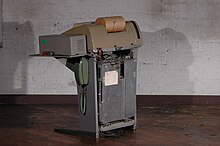
The Bell 101 Dataset was the first commercial modem for computers, released by AT&T Corporation in 1958 for use by SAGE, and made commercially available in 1959, shortly after AT&T's Bell Labs announced their 110 baud modulation frequencies. The Bell 101 allowed digital data to be transmitted over regular unconditioned telephone lines at a speed of 110 bits per second.
Bell 101 modems are no longer in use and were quickly replaced by its successor the Bell 103 modem. SAGE modems were described by AT&T's Bell Labs as conforming to the Bell 101 data set standard.
See also
References
- "Getting connected: a history of modems". TechRadar. Retrieved 2017-07-01.
- "Bell Telephone Laboratories, Inc. List of Significant Innovations & Discoveries (1925-1983)". Retrieved 2017-07-01.
Further reading
- Weber, Laurance A. (1959). "A frequency-modulation digital subset for data transmission over telephone lines". Transactions of the American Institute of Electrical Engineers, Part I: Communication and Electronics. 77 (6): 867–872. doi:10.1109/TCE.1959.6372907. S2CID 51673551.
- Soffel, R. O.; Spack, E. G. (1959). "SAGE data terminals". Transactions of the American Institute of Electrical Engineers, Part I: Communication and Electronics. 77 (6): 872–879. doi:10.1109/TCE.1959.6372908. ISSN 0097-2452. S2CID 51676153.
- Data Set 101C: Identification and Operation (PDF). Bell System Practices. AT&T Co. March 1963.
- Kline, Ronald R. (2019). "The Modem that Still Connects Us". Historical Studies in Computing, Information, and Society. History of Computing. pp. 29–50. doi:10.1007/978-3-030-18955-6_3. ISBN 978-3-030-18954-9. S2CID 213434332.
| Amateur radio digital modes | ||
|---|---|---|
| Frequency-shift keying (FSK) |  | |
| Multiple frequency-shift keying (MFSK) | ||
| Phase-shift keying (PSK) | ||
| COFDM |
| |
| Non-traditional digital modes | ||
This article related to telecommunications is a stub. You can help Misplaced Pages by expanding it. |